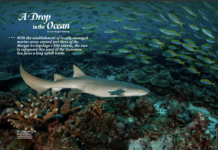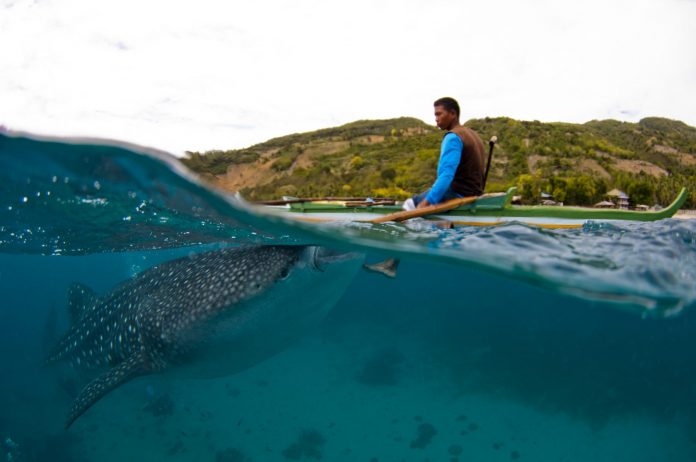
As another whale-shark-feeding destination crops up, Scubazoo’s Aaron “Bertie” Gekoski explores this controversial industry
Text and photos Aaron “Bertie” Gekoski
There’s a whale shark in the way of my whale shark. That’s not a thought one has often in one’s lifetime. But here I am, off the coast of remote Indonesian Borneo, photographing the world’s largest fish, when another one comes barrelling through, spoiling my photo and nearly causing me to drop my (incredibly pricey) underwater camera and lighting set up.
I steady myself and get back to the matter at hand of taking a split-level shot of a rather surreal scene: a whale shark – hanging vertically in the water column – having bait poured into its mouth by fishermen off the side of a floating platform, known as a bagan.
On and beneath the surface, all parties appear to be having (ahem) a whale of a time; four gigantic sharks are getting a good feed, the fishermen are making some money, and we’re gathering top-drawer imagery for our new series, Indonesia from Below. It’s a win-win-win situation. Right?
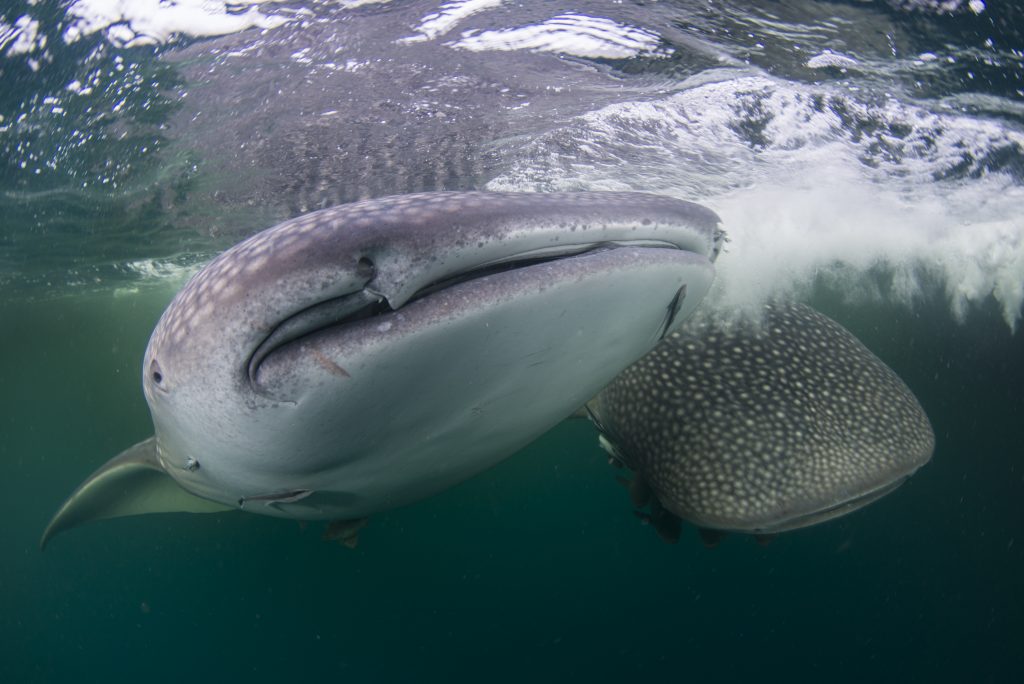
Multiple sharks compete for food in Derawan (Image © Aaron “Bertie” Gekoski/Scubazoo)
If only it were that simple. Whether or not whale sharks should be hand-fed for tourism is a highly debated subject amongst scientists and conservationists. Some view it as integral to the sharks’ survival. Others want the feeding to stop, claiming it results in disfigured, overfed, lazy sharks that will struggle to reproduce.
Let’s start with the pros. Globally, whale shark tourism is valued in excess of USD50 million per annum, with the feeding hot spots being Oslob in the Philippines, and Gorontalo and Cenderawasih in Indonesia. As a result of the industry, jobs are created, lodging and restaurants spring up, and infrastructure is improved.
Dr Mark Meekan, Principal Research Scientist at the Australian Institute of Marine Science, believes the impact on the people of Oslob – perhaps the best-known shark-feeding destination – has been overwhelmingly positive. “The industry has changed the fishermen’s lives for the better here. They’re eating three meals a day and can afford to send their children to school,” he says.
If we could replicate Oslob across Southeast Asia, I think it would ensure the future of whale sharks in that region for many years. It would be the single most important conservation action you could do.
-Dr Mark Meekan, Principal Research Scientist at the Australian Institute of Marine Science
It’s not just the community that benefits. In an era of diminishing marine resources, near-guaranteed whale shark sightings are a huge draw for tourists. They leave having had intimate encounters with gigantic animals. The photos they post on social media help to dispel myths that sharks are bloodthirsty man-eaters: I swam with a 10-metre shark and survived! Here’s a selfie to prove it…
Whale sharks could do with all the positive PR and help they can get right now. On the high seas, they are the victims of by-catch, caught in nets large enough to ensnare a dozen Boeing 747s. Then, there’s the value of their fins, which can command high prices as display items in Hong Kong. Due to these threats, last year the whale sharks’ conservation status was upgraded from “vulnerable” to “endangered” on the IUCN Red List of Threatened Species.
Whale sharks are endangered because of us; their populations worldwide have more than halved because of us. Therefore, it’s reasonable to assume that humans can provide the solutions.
For Meekan, hand-feeding is the future. “If we could replicate Oslob across Southeast Asia, I think it would ensure the future of whale sharks in that region for many years. It would be the single most important conservation action you could do.”
Related story: Making a Movement
Related story: Nowhere to Escape
Related story: The Lungs of the Earth
What about the sharks?
Co-founder of Marine Megafauna Foundation and whale shark expert, Dr Simon Pierce, who led the global conservation assessment for the species last year, offers more cautious support for the industry. “Whilst tourism can certainly be positive, there has to be something in it for the sharks. There’s no clear benefit from some of these feeding sites,” he says.
Many of the whale sharks seen in Oslob have spongy lesions on their mouths, a result of rubbing up on boats in an effort to be fed. Others have propeller strikes on their face, or damaged fins. A 2014 study found that 47 percent of Oslob sharks had propeller injuries.
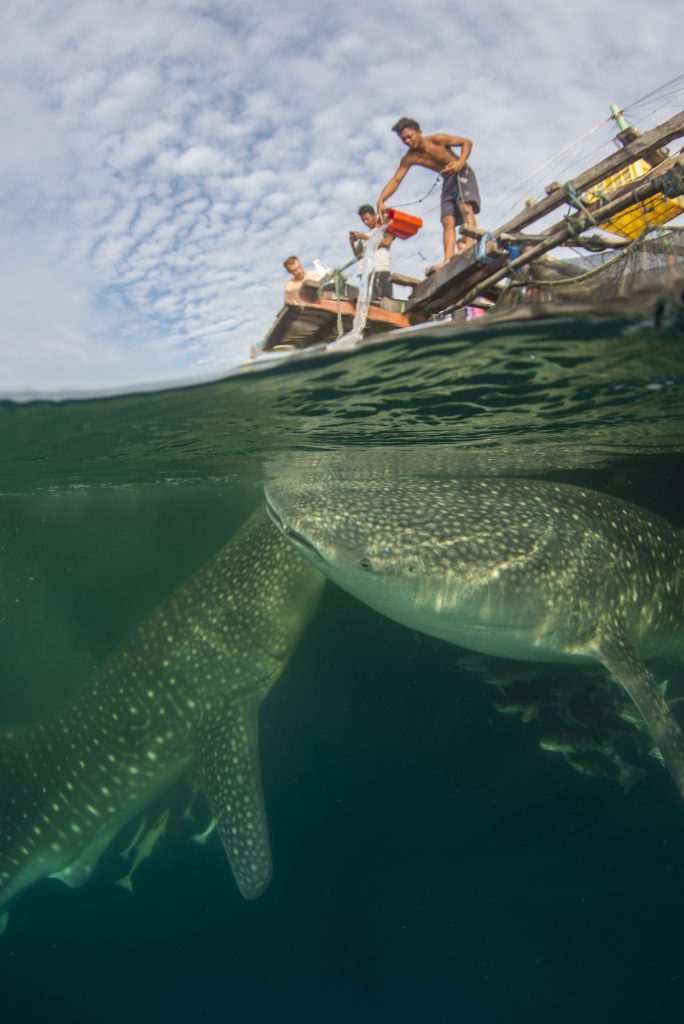
Bait is poured directly into the sharks’ mouths in an attempt to keep them around for tourists to swim with (Image © Aaron “Bertie” Gekoski/Scubazoo)
Another common criticism is people touching the sharks. Large Marine Vertebrates Research Institute Philippines (LAMAVE) monitored tourist interactions with whale sharks for nearly 4,000 minutes, noting 1,823 active touches by feeders and tourists. In 2014, compliance to a Code of Conduct stating that all snorkellers must stay at least two metres away from the sharks was at three percent.
“Despite having a thick skin, whale sharks are very sensitive to being touched. If a shark is grabbed, it can perceive it as a threat,” says Dr Pierce. “I’ve often seen them crash-dive in response to contact under natural conditions. It’s a shame to scare the sharks like that, and it could be dangerous for swimmers. Despite being extremely gentle, these are large animals, and getting hit by their tail could cause severe injury.”
Furthermore, the whale sharks’ feed is often limited to frozen shrimp or one species of fish. Too much food can also be detrimental to their health. With such plentiful supplies, there is little incentive to leave an area, resulting in “habituated” animals.
Whale sharks are an iconic, endangered species and it’s a privilege for us to be able to interact with them. But they are not our playthings.
– Dr Simon Pierce, Co-founder of Marine Megafauna Foundation
Studies of 158 whale sharks in Oslob by LAMAVE between 2012 and 2013 highlighted that residency time for hand-fed whale sharks was 44.9 days, compared to 22.4 for non-provisioned individuals. Twelve individuals were seen on at least 50 percent of observation days. The paper concludes: “Extended residency and differences in lagged identification rates suggest behavioural modification on provisioned individuals, underlying the necessity for proper management of this tourism activity.”
What’s clear is that feeding makes the sharks stay in one place longer. What’s not clear is the impact this has on the sharks. For Dr Meekan, having “resident” sharks isn’t a problem. “Anyway, even if some sharks are lost to the population forever, that would be a small price to pay for the conservation of the entire species,” he says, whilst referring to these sharks as “global ambassadors”.
Further research of this “ecotourist” activity is currently underway in Cenderawasih Bay, where dozens of sharks have been deployed with custom-made satellite tags. Every day, scientists are gathering vital insights into the lives of these mysterious animals. Once we understand them, management strategies can be put in place to ensure all parties benefit: the community, tourists, and sharks.
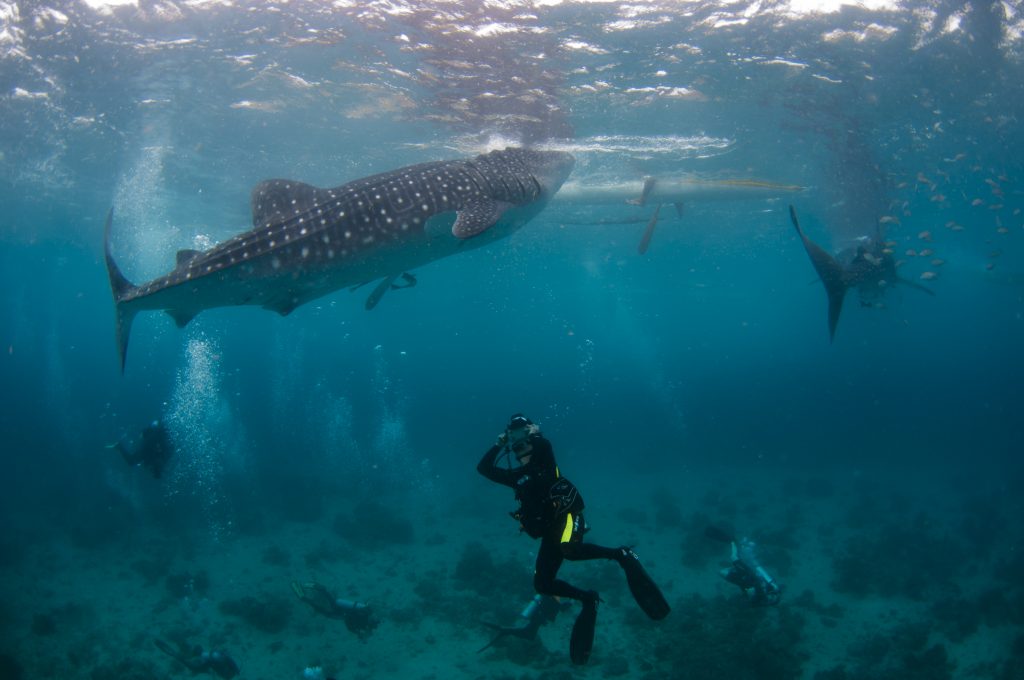
In Oslob, the sharks can be observed from above and below the surface, as divers wrestle for the optimal shooting position (Image © Jason Isley/Scubazoo)
“Animal health and life history data collected via this project will support the refinement of existing guidelines to ensure that ecotourism does not adversely impact their health or natural behaviours,” says project leader, Mark Erdmann, Vice-President of Asia-Pacific Marine Programs at Conservation International.
Departing Derawan
We leave Derawan with positive memories and striking imagery, though not without our concerns. During our stay, we heard multiple reports that some fishermen would stand on the sharks’ heads in order to feed them, whilst grabbing onto fins and “riding” the whale sharks was commonplace amongst tourists.
“I don’t think anyone would argue that there is a clear economic benefit to the community, but negative impacts on the sharks still need to be avoided. Whale sharks are an iconic, endangered species and it’s a privilege for us to be able to interact with them. But they are not our playthings,” says Dr Pierce, who visited the area recently.
The benefits of whale-shark-feeding for tourists and the local community are evident, but careful monitoring and stricter regulations are needed to minimise the impact on the sharks. There are many grey areas in this contentious industry, though one thing’s for sure: So long as there are whale sharks, it’s here to stay.
For more stories from this issue, get your copy of Asian Geographic Issue 127, 2017





